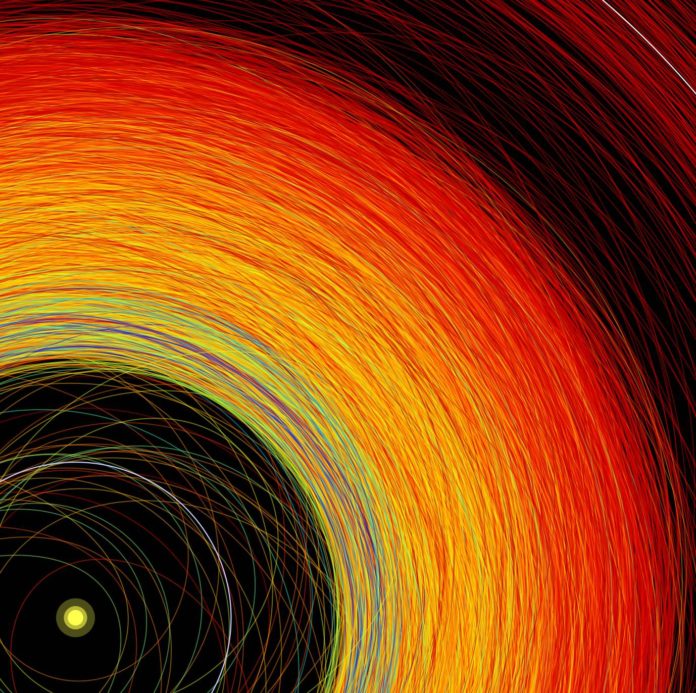The European Space Agency‘s Gaia mission has created the richest star catalog to date, including high-accuracy estimations of about 1.7 billion stars and uncovering already inconspicuous subtle elements of our home Galaxy.
Gaia’s mission is to provide the largest, most precise three-dimensional map of our Galaxy ever created. This latest release is based on 22 months of charting the sky, as part of Gaia’s mission to produce the largest, most precise three-dimensional map of our Galaxy ever created. It includes positions, distance indicators and motions of more than one billion stars, along with high-precision measurements of asteroids within our Solar System and stars beyond our own Milky Way Galaxy.
Günther Hasinger, ESA Director of Science said, “The observations collected by Gaia are redefining the foundations of astronomy. Gaia is an ambitious mission that relies on a huge human collaboration to make sense of a large volume of highly complex data. It demonstrates the need for long-term projects to guarantee progress in space science and technology and to implement even more daring scientific missions of the coming decades.”
Cambridge’s Professor Gerry Gilmore said, “There is hardly a branch of astrophysics which will not be revolutionized by Gaia data. “The global community will advance our understanding of what we see, where it came from, what it is made from, how it is changing. All this is made freely available to everyone, based on the dedicated efforts of hundreds of people.”
The new information release, which covers the period between 25 July 2014 and 23 May 2016, binds the places of about 1.7 billion stars, and with a substantially more prominent exactness. For a portion of the brightest stars in the study, the level of exactness compares to Earth-bound eyewitnesses having the capacity to detect a Euro coin lying on the surface of the Moon.
With these exact estimations it is conceivable to isolate the parallax of stars – a clear move on the sky caused by Earth’s yearly circle around the Sun – from their actual developments through the Galaxy. The new index records the parallax and speed over the sky, or appropriate movement, for in excess of 1.3 billion stars. From the most precise parallax estimations, around 10% of the aggregate, space experts can specifically evaluate separations to singular stars.
The thorough dataset gives an extensive variety of subjects for the space science group. And additionally positions, the information incorporate brilliance data of all overviewed stars and shading estimations of about all, in addition to data on how the shine and shade of a large portion of a million variable stars change after some time. It additionally contains the speeds along the observable pathway of a subset of seven million stars, the surface temperatures of around a hundred million and the impact of interstellar tidy on 87 million.
Dr. Francesca De Angeli, head of the Cambridge processing center said, “This data release has proven an exciting challenge to process from spacecraft camera images to science-ready catalogs. More sophisticated strategies and updated models will be applied to the Gaia data to achieve even more precise and accurate photometric and spectrophotometric information, which will enable even more exciting scientific investigations and results.”
Gaia also observed objects in our Solar System: the second information discharge involves the places of in excess of 14,000 known space rocks, which permits exact assurance of their circles. A considerably bigger space rock test will be aggregated in Gaia’s future discharges.
Promote abroad, Gaia surrounded the places of a large portion of a million removed quasars, splendid systems controlled by the action of the supermassive black holes at their centers. These sources are utilized to characterize a reference outline for the divine directions of all articles in the Gaia inventory, something that is routinely done in radio waves however now out of the blue is additionally accessible at optical wavelengths.
Real revelations are required to come once researchers begin investigating Gaia’s new discharge. An underlying examination performed by the information consortium to approve the nature of the inventory has effectively divulged some encouraging astonishment – including new experiences on the advancement of stars.
Dr. Dafydd Wyn Evans said, “Gaia has so far observed each of its more than 1.7 billion sources on average about 200 times. This very large data set has to have all the changing satellite and sky responses removed, and everything converted on to a well-defined scale of brightness and color. While a huge challenge, it is worth it.”
Van Leeuwen, Project Manager for the UK and European photometric processing work said, “Groups of dwarf galaxies, including the Magellanic Clouds, can now be observed to be moving around in very similar orbits, hinting at a shared formation history. Similarly, a pair of globular clusters has been observed with very similar orbital characteristics and chemical composition, again pointing towards a shared history of formation. The accurate observed motions and positions of the globular clusters and dwarf galaxies provide tracers of the overall mass distribution of our galaxy in a way that has not been possible with this level of accuracy before.”
Scientists believe that the additional data will be provided soon until the 2020s. This will include the definitive stellar catalog for the foreseeable future, playing a central role in a wide range of fields in astronomy.
Gilmore said, “This vast step into a new window on the Universe is a revolution in our knowledge of the contents, motions, and properties of our local Universe. We look forward to the international astronomical community building on this European project, with its major UK contributions, to interpret these Gaia data to revolutionize our understanding of our Universe. This is a magnificent harvest, but cornucopia awaits. We are all proud to be part of this magnificent project.”
